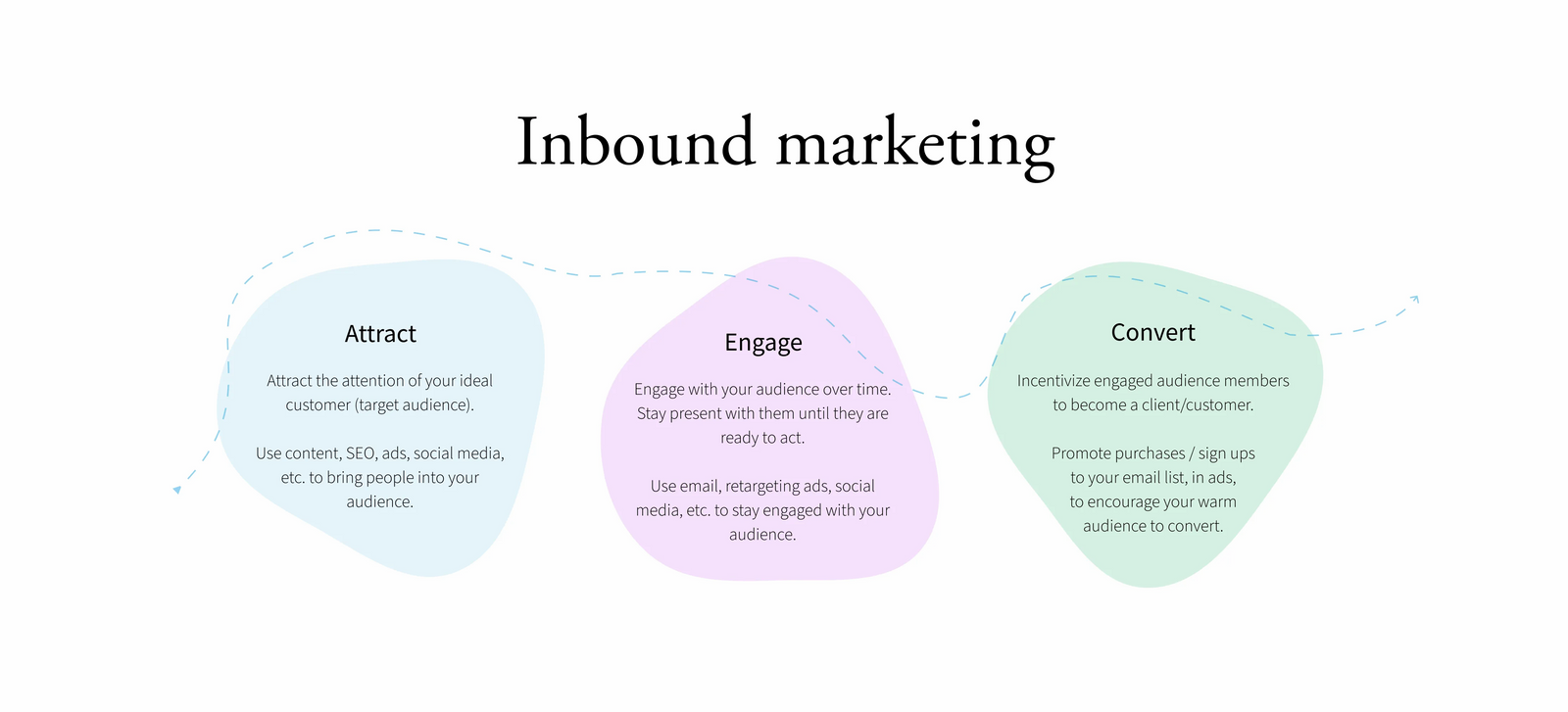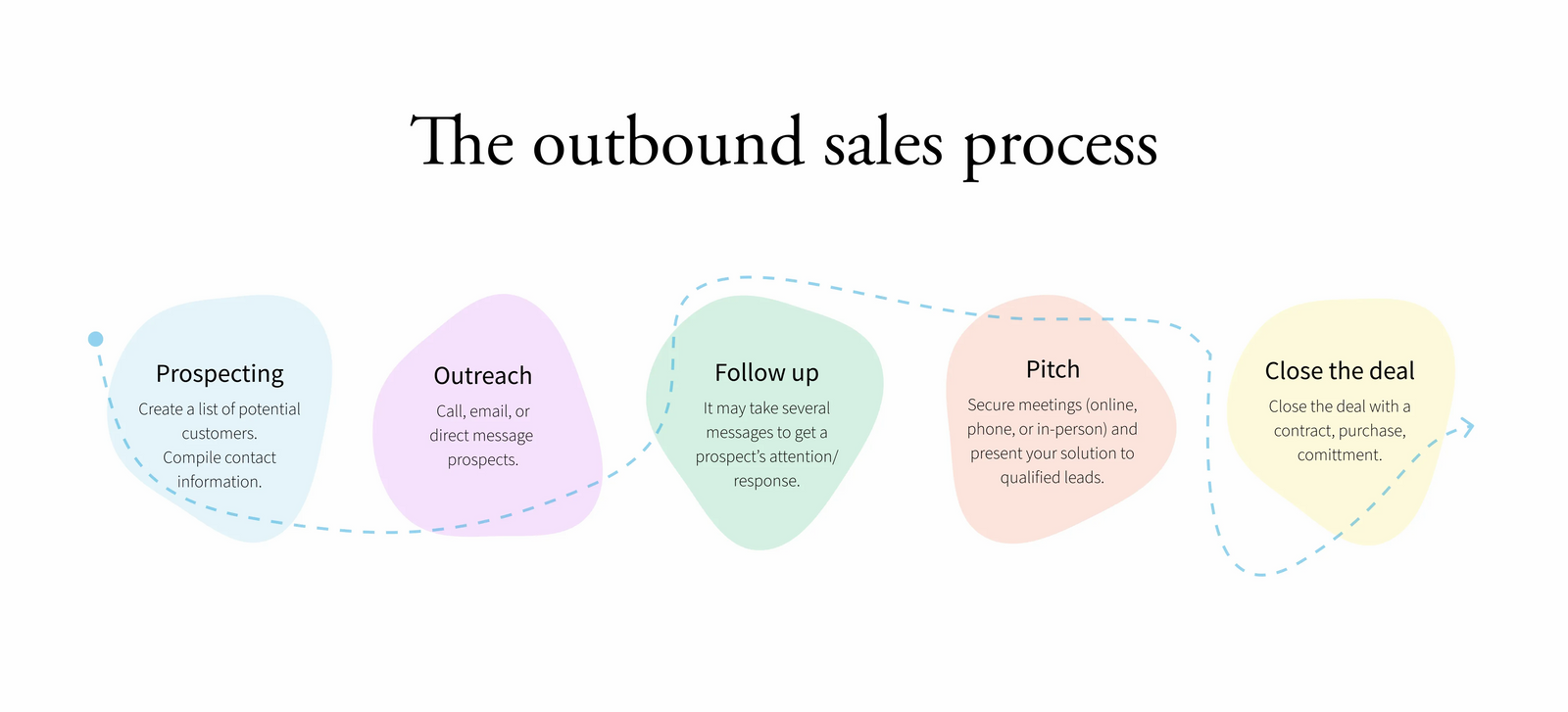
Marketing strategies for small business – inbound marketing vs. outbound sales.Which is right for your business?
Jessica Baldwin / Published June 22, 2023
Are you searching for how to grow your small business?
Wading through the sea of marketing advice can be challenging. You might read articles or hear stories from other entrepreneurs who claim that a certain marketing tactic works wonders. However, you might not get the same results when you try those same things. No "one size fits all" marketing strategy works for all small businesses. You need to figure out the right combination of marketing activities that best suit your brand.
It's essential to understand two popular but distinctly different business marketing strategies: inbound marketing and outbound sales.
Inbound marketing focuses on attracting and engaging potential customers through valuable content and experiences. Inbound marketing typically involves content creation, search engine optimization (SEO), social media, email marketing, pay-per-click advertising, and more. The goal is to get your ideal customer's attention, stay engaged with them over time, and incentivize them to purchase.
It works well for businesses offering low to mid-priced items or services that can be easily understood and purchased online. However, it's important to remember that inbound marketing requires time and consistent effort to reach a large audience and build brand awareness.
Outbound sales, also known as proactive or direct sales, is a sales approach where a company or salesperson initiates contact with potential customers to generate leads and close sales. Unlike inbound marketing, which focuses on marketing campaigns that attract customers through content and engagement, outbound sales involves actively reaching out to prospects.
In outbound sales, sales representatives (often the business owner themselves) proactively contact prospects by cold calling, emailing, sending direct mail, or going door-to-door. The objective is to identify potential buyers, present products or services, and convince them to purchase or take the desired action. It is particularly effective for businesses offering products or services that require personalized interaction.
Which strategy is right for your business? You can employ either strategy or a combination of both, depending on the type of business and your marketing goals.
Understanding inbound marketing

In inbound marketing, brands create content and use various marketing channels to attract their target market's attention and pull them "in" to their audience. The prospective customer begins their journey with the brand by reading an article, visiting the website, interacting on social media, listening to a podcast episode, etc.
Once they are in the brand's audience, additional messaging is developed to engage with the audience over time through email campaigns, retargeting ads, ongoing social media marketing, and more. Further, promotions are presented to the audience at specific points within the customer journey to drive sales.
An inbound strategy aims to attract the right people, nurture engagement over time, and incentivize the audience to become customers. To achieve these goals, you can employ various marketing initiatives:
Search engine optimization (SEO) focuses on improving your website's visibility in search engine results. You can attract more visitors by optimizing your content, incorporating relevant keywords, enhancing user experience, and organizing your website effectively.
Content marketing involves creating valuable and relevant content, such as blog posts, videos, or infographics, to engage and educate your audience. It helps establish your brand as a thought leader, build trust, and attract potential customers by addressing their needs and providing valuable insights.
Social media platforms offer opportunities to connect with and engage your target audience. Creating compelling social media posts, interacting with followers, and using targeted advertising can raise brand awareness, foster a loyal community, and drive traffic to your website or online store.
Email is an effective marketing tool to nurture leads, communicate with customers, and promote products or services. Crafting personalized and engaging email campaigns allows you to build relationships, drive conversions, and encourage repeat business. Targeted messages delivered directly to an email list of engaged subscribers increase engagement and improve conversion rates.
Podcasts, YouTube channels, and other multimedia platforms provide avenues to showcase your brand's expertise, share insights, and reach a wider audience. Engaging audio or video content can attract followers, enhance brand visibility, and direct traffic to your website or social media channels. Collaborations and partnerships on these platforms expand your reach and influence.
Participating in online communities relevant to your industry or target audience is an effective online marketing tactic. Engage in discussions, share valuable insights, and network with community members to establish your business as a trusted authority. Online communities offer opportunities for brand advocacy, customer feedback, and collaboration, contributing to the success of your digital marketing strategy.
Pay-per-click (PPC) and social media advertising enable you to place targeted ads on search engines or social media platforms. This approach increases online visibility, drives targeted traffic, and provides quick results. Online advertising offers measurable outcomes and precise targeting, making it an essential part of a small business's digital marketing strategy.
You can combine several online marketing strategies to design a funnel that gets your brand noticed, grows an audience amongst your target market, and drives sales for your product or service.

Is inbound marketing right for your small business?
Inbound marketing is a powerful strategy that can benefit many types of businesses. It leverages several generally low-cost marketing channels like email and social media. Inbound marketing helps build brand authority and trust amongst your audience. Once your funnel is in place and optimized, inbound marketing can produce predictable, scalable, long-term results.
However, it's crucial to keep the following points in mind:
1) Inbound marketing takes time to produce results.
Strategies like SEO and content marketing require patience as they may take several months to generate noticeable organic website traffic and gain momentum. Moreover, the sales cycle for your product may be longer than anticipated, meaning it could take several months for a potential customer to make a purchase after their initial interaction with your brand.
2) Building a substantial audience is key to success.
Inbound marketing works best when you reach many people at the top of the marketing funnel. It's important to understand that a smaller percentage of these individuals will convert into actual customers. Therefore, be prepared to engage with thousands of people before you start seeing significant results in terms of conversions and sales.
3) A holistic approach is necessary for an effective inbound marketing strategy.
Relying solely on your website or SEO efforts is insufficient. Inbound marketing requires a well-rounded marketing plan that encompasses various touchpoints and channels. By utilizing different tactics, such as social media, email marketing, and content creation, you can create a comprehensive and effective marketing funnel that engages potential customers at every stage of their journey.
4) There's a lot to learn.
Implementing an effective inbound marketing strategy requires acquiring diverse skills and knowledge (from content creation to SEO to email marketing, online ads, and more). For small businesses or solopreneurs, possessing all the expertise necessary to execute the strategy successfully can be challenging. It may be beneficial to seek external resources, such as outsourcing specific tasks or investing in training programs, to overcome these skill gaps and ensure the strategy's successful implementation.
While inbound marketing can be advantageous, it's essential to understand that it takes time to yield results, requires reaching a substantial audience, necessitates a holistic marketing approach, and can have a steep learning curve. By considering these factors, you can maximize the impact of your inbound marketing efforts and achieve long-term success for your business.
Learn more about creating a marketing funnel here.
An inbound marketing example
Imagine a health coach business that specializes in personalized wellness programs. The health coach creates informative and engaging blog posts, social media content, and YouTube videos about nutrition, exercise, and stress management to attract their target audience. They optimize their website with relevant keywords and implement SEO strategies to rank higher in search results. By consistently sharing valuable content and offering free resources like healthy recipe ebooks or workout guides, they attract individuals interested in improving their well-being.
Once the audience is drawn in, the health coach nurtures engagement over time. They encourage readers to subscribe to their email newsletter, where they provide exclusive tips, success stories from clients, and invites to live webinars or Q&A sessions. The health coach actively responds to comments and direct messages through social media, fostering a sense of community and building trust with their audience. This ongoing engagement helps to establish the health coach as a knowledgeable and supportive expert in the field.
To incentivize conversions, the health coach offers a limited-time promotion for their personalized wellness programs, providing a discount or a bonus coaching session to those who sign up within a specific period. They also offer a free initial consultation, allowing potential clients to experience the value of their coaching firsthand. The health coach creates a positive customer experience that encourages referrals and repeat business by providing expert service and delivering results. Through these steps of attracting the target audience, engaging over time, and incentivizing conversions, the health coach effectively utilizes inbound marketing to grow their business and help more individuals achieve their health goals.
By implementing a well-executed inbound marketing strategy, your business can attract interested prospects, engage with them through valuable content and interactions, and convert them into loyal customers.
Understanding outbound sales

Outbound sales is a proactive approach to sales and customer acquisition where you initiate direct contact with potential customers. Unlike inbound marketing, which focuses on attracting leads through content and online channels, outbound sales involves actively reaching out to prospects through methods like cold calling, email campaigns, and direct mail.
Outbound sales typically involves a dedicated sales team or individual who identifies and targets potential customers, initiates conversations, and follows up to convert leads into paying customers. It requires effective communication skills, persistence, and a systematic approach to prospecting and nurturing strong relationships.
Outbound sales can be particularly beneficial for small businesses looking to make targeted and personalized connections with potential customers, establish rapport, and drive direct sales.
Outbound sales tactics include:
Prospecting is the first step to a successful outbound sales strategy. Successful outbound sales strategies rely on connecting with people who need your product or service. Identifying and qualifying potential customers who fit your target customer is important. You can create a prioritized list of potential clients or customers to focus your sales efforts on through prospecting.
Direct outreach happens once you have a list of prospects. You can reach out through cold calling, personalized emails, or social media messages. The goal is to introduce your business, establish a connection, and initiate a conversation with the prospect. By engaging in direct outreach, you create opportunities to showcase your products or services, address customer needs, and build relationships that can lead to sales conversions.
Nurturing leads is a crucial aspect of your outbound sales strategy. Once you make initial contact, it's essential to follow up with leads to maintain engagement and build trust over time. This may involve sending personalized follow-up emails, providing additional information or resources, or scheduling follow-up calls or meetings. By nurturing your leads, you keep your brand top of mind, address any concerns or objections, and guide potential customers through the sales process, ultimately increasing the chances of closing a sale.
Making sales presentations is an important tactic for your outbound sales efforts. You need to showcase your products or services in a structured and persuasive manner. You may deliver presentations in person, via video conference, or through pre-recorded videos. Focus on highlighting the value and benefits of your offerings, addressing specific customer pain points, and showcasing how your solutions can meet their needs. By delivering compelling sales presentations, you can effectively communicate your value proposition and move prospects closer to making a purchase decision.
Closing the sale is the ultimate goal of your outbound sales strategy. This is where a prospect becomes a paying customer. Utilize various closing techniques, such as offering incentives, negotiating terms, or providing limited-time offers, to encourage prospects to make a buying decision. Effective closing requires active listening, understanding customer needs, and addressing any remaining concerns or objections. By successfully closing the sale, you turn your efforts into tangible revenue and forge long-term customer relationships.

Is outbound sales the right approach for your small business?
Outbound sales is a dynamic strategy that can deliver significant benefits to your business. It involves proactive outreach and direct communication with potential customers to generate leads and drive sales. Outbound sales allows you to take control of your sales process by actively seeking out prospects and initiating contact. It can provide quick and measurable results, making it an effective strategy for businesses looking for immediate sales impact.
Outbound sales can be a powerful tool in your sales arsenal. However, it's essential to consider the following points:
1) Outbound sales requires a proactive and targeted approach.
Unlike inbound marketing, which focuses on attracting interested prospects, outbound sales requires reaching out to potential customers who may not be familiar with your brand. It requires identifying and targeting specific individuals or companies that align with your ideal customer profile. This proactive approach demands thorough research, personalized messaging, and strategic planning to maximize the chances of success.
2) Building and maintaining relationships is crucial.
Outbound sales is not just about making a single sale; it's about building and nurturing relationships with your prospects. It involves effective communication, active listening, and understanding your potential customer's needs and pain points. By establishing trust and providing value throughout the sales process, you can cultivate long-term customer relationships and generate repeat business.
3) Balancing volume and quality is key.
You'll need to reach out to a larger number of prospects to increase the chances of conversions. However, it's important to strike a balance between quantity and quality. Instead of casting a wide net, focus on identifying high-potential leads and investing your time and effort in building meaningful connections with them. Quality interactions and targeted messaging can yield better results than a sheer volume of outreach.
4) There's a learning curve to mastering outbound sales.
Implementing an effective outbound sales strategy requires developing specific skills and techniques. From prospecting and lead qualification to cold calling, email outreach, and sales presentations, there are various aspects to master. Consider investing in training, leveraging technology tools, or partnering with experts to enhance your outbound sales capabilities.
While outbound sales can be a fruitful approach, it's essential to recognize that it requires a proactive and targeted mindset, emphasizes relationship-building, necessitates a balance between volume and quality, and comes with a learning curve. By considering these factors, you can optimize your outbound sales efforts and successfully generate leads and drive sales for your business.
An outbound sales strategy example
Imagine a small software development company called TechSolutions. They specialize in creating customized software solutions for businesses in various industries.
To expand its client base, TechSolutions implements an outbound sales strategy. They start by prospecting, conducting market research to identify potential customers in sectors that would benefit from their software solutions. Once they have a list of leads, their dedicated sales team engages in direct outreach, reaching out to decision-makers via personalized emails and phone calls. They introduce themselves, highlight the unique features of their software, and offer to schedule a product demonstration.
Through consistent follow-ups and nurturing leads with additional information and case studies, TechSolutions builds relationships and demonstrates its expertise. When prospects show interest, the sales team conducts detailed sales presentations, showcasing how their software can streamline operations, increase efficiency, and drive growth for the client's business.
Finally, by addressing concerns, negotiating terms, and offering tailored pricing options, TechSolutions successfully closes deals, securing new clients and revenue streams. Through their outbound sales strategy, TechSolutions effectively targets and engages potential customers, positioning themselves as a trusted software provider in their industry.
By employing an effective outbound sales strategy, your business can actively reach out to potential customers, nurture relationships, and drive direct sales, ultimately achieving higher revenue and establishing a solid position in the market.
Which strategy will help grow your small business?
Choosing the best marketing and sales strategy for your small business requires careful consideration. Think about your target customer and what type of experience they may expect in acquiring your product or service. Try to match your marketing strategy to their preferences.
Suppose you sell business consulting services to large corporations. An outbound sales strategy is likely necessary to find the right decision-maker and cultivate a relationship to win the business. In comparison, a consumer looking for the latest trendy footwear will likely search for products online and respond well to social media content. In this case, inbound marketing is more likely to drive sales.
You should also consider how soon your company needs to generate revenue from your efforts. Inbound strategies often require a lot of testing, refining, and scale to start producing results. Whereas identifying prospects and contacting them directly is something you can implement immediately.
It's important to note that you don't have to choose just one strategy. A combination of outbound sales and digital marketing can work well together. The key is continuously refining your tactics to align with your business goals and effectively reach and convert your target audience. Ultimately, the proper marketing and sales strategy is the one that suits your specific business needs and helps drive growth and success.
Free workbook: Win customers with your website!
Create a strategy to get more leads and sales from your website.







